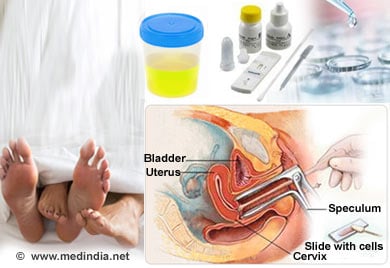- Meyers D, Wolff T, Gregory K, Marion L, Moyer V, Nelson H, et al. USPSTF Recommendations for STI Screening. American Family Physician 2008; 77(6): 819-824.
- Miller KE. Diagnosis and Treatment of Chlamydia trachomatis Infection. Am Fam Physician 2006;73:1411-6.
- Screening Tests To Detect Chlamydia trachomatis and Neisseria gonorrhoeae Infections - (http://www.cdc.gov/mmwr/preview/mmwrhtml/rr5115a1.htm)
- Land J.A., Van Bergen J.E.A.M., Morre' S.A., and Postma M.J.. Epidemiology of Chlamydia trachomatis infection in women and the costeffectiveness of screening. Human Reproduction Update 2010; 16 (2): 189–204
About
Chlamydial infection may not cause any symptoms initially, though it may be associated with serious complications like infertility and ectopic pregnancy in later stages.
Chlamydial infection is a

In women, chlamydial infection usually affects the lower tubular part of the uterus referred to as the cervix and usually spares the vagina. Symptoms may be absent in the initial stages. Chlamydial infection may cause an increase in odorless vaginal discharge with or without itching. The cervix may appear inflamed and may bleed easily when examined with a swab or a spatula.
The infection may spread upwards to affect the inner lining of the uterus, a condition called endometritis. If the fallopian tubes are affected, the condition is called salpingitis. Endometritis and salpingitis result in a condition called pelvic inflammatory disease. Symptoms of pelvic inflammatory disease include severe abdominal pain, high fever, pain during intercourse, prolonged menses, and bleeding between menstrual periods. Pelvic inflammatory disease can result in infertility, chronic pelvic pain and ectopic pregnancy (pregnancy occurring outside the uterus, usually in the fallopian tubes). These complications make it very important to diagnose the condition in high-risk women preferably before the onset of any symptoms.
Chlamydial infection can also affect the urethra or the lower part of the bladder through which the urine is excreted, the condition being called urethritis. The patient experiences pain during urination.
Chlamydial infection spreads through vaginal, anal or oral sex. If the mother is infected, the infection could spread to the eyes of a newborn during delivery resulting in blindness. It may also cause pneumonia in the newborn.
Chlamydia can also affect men, causing urethritis (inflammation of the urethra) and epididymitis (inflammation of a part overlying the testis), though routine screening is not recommended in men. Inflammation of the rectum referred to as proctitis may occur in men indulging in anal intercourse.
Chlamydial infection may rarely cause a condition called Reiter’s syndrome which is characterized by arthritis, conjunctivitis (inflammation of the outer lining of eyes) and urethritis. This condition affects men more often than women.
Screening for Chlamydial Infection
Screening for chlamydial infection is recommended in women over the age of 25 years engaged in high-risk sexual behavior as well as in women below the age of 25 years who are sexually active.
Why is screening for chlamydial infection important?
Screening for chlamydial infection is important for the following reasons:
- Chlamydial infection does not cause any symptoms in the initial stages. Thus, it can be detected only through screening.
- Chlamydial infection once diagnosed is very easy to treat with antibiotics.
- Untreated chlamydial infection can cause a serious complication called pelvic inflammatory disease, which could lead to chronic pelvic pain, infertility and ectopic pregnancy (pregnancy outside the uterus).
Thus, screening is important to detect and treat the infection in its early stages before the onset of any complications. In addition, screening also helps to reduce sexual transmission of the infection.
Who should undergo screening for chlamydial infection?
Current guidelines indicate that screening for chlamydial infection should be carried out in the following nonpregnant as well as pregnant women:
- Women who engage in high-risk sexual behavior. These behaviors include:
- Having multiple current partners
- Having a new partner
- Using condoms inconsistently
- Having sex while under the influence of alcohol or drugs
- Having sex in exchange for money or drugs
- Sexually active women less than 25 years of age even if they do not indulge in high-risk sexual behaviors. This is necessary since younger women are more at risk for developing the infection due to their lower immunity status, immaturity of the cervical epithelium and likelihood of having more new sex partners.
Routine screening is not necessary in women over the age of 25 years not involved in high-risk sexual behavior.
How often should tests for Chlamydia infection be repeated?
Screening for chlamydial infection in women at high risk for developing the infection should preferably be repeated every year.
Which are the preferred tests for detecting chlamydial infections?
Tests referred to as Nucleic Acid Amplification Tests (NAATs) are used to diagnose chlamydial infection. These tests use various techniques like polymerase chain reaction (PCR), transcription mediated amplification (TMA), and the DNA strand displacement amplification (SDA). These tests are accurate and convenient to carry out. They have thus replaced the traditional culture tests in the screening for chlamydial infection.
Tests for chlamydial infection may be carried out on cervical swabs or urine samples in woman, or on urine samples or urethral swabs from men.
Some of these tests may be less sensitive when conducted on urine as compared to cervical swab.
Frequently Asked Questions
1. Which doctor should I visit to get a test for chlamydial infection done?
You should visit your gynecologist or venereal disease specialist to get tested for chlamydial infection. In some cases, your general physician may also conduct the test.
2. When should a woman stop screening for chlamydial infection?
Though there is no specific recommendation regarding when to stop screening for chlamydial infection, screening may be stopped once a woman has reached menopause. This is because the woman is no longer exposed to the complications of chlamydial infection like ectopic pregnancy and infertility which she is normally exposed to before menopause.
3. What are the other tests used to diagnose chlamydial infection?
Other tests used to diagnose chlamydial infections are:
- Cell culture tests: Culture techniques are available for chlamydial infections but are not suitable for screening due to their low sensitivity (ability to detect an infection), increased time for results, technical difficulties and high cost. However, if the test is positive, it is 100% sure that the patient is suffering from Chlamydial infection.
- Other nonculture tests also available for chlamydial infection include Nucleic Acid Hybridization (Nucleic Acid Probe) Tests (which are not specific for chlamydial infection and are positive in the presence of gonococcal infection as well), DFA tests (which are time consuming and require a technician trained in fluorescent microscopy) and EAI tests (which are less sensitive than NAATs).
- Rapid tests or Point-of-Care tests are also available that permit quick diagnosis, but they are less sensitive and specific than laboratory tests as well as more costly.
4. What happens if the test result is positive for chlamydial infection?
If the screening test is positive for chlamydial infection, you could either receive treatment with antibiotics or reconfirm the result using an alternative test.










